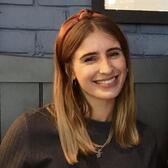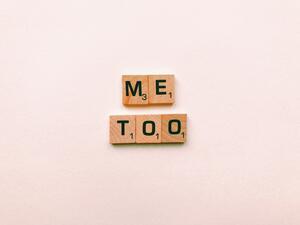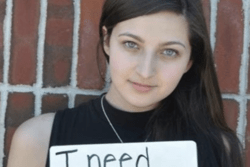The Work of a Movement: #MeToo and Vicarious Trauma
#MeToo. Photo by Shamia Casiano via Pexels.
It’s been just over two years since the hashtag #MeToo—which refers to the social media movement founded by civil rights activist Tarana Burke in 2006—went viral; in 2017, sexual allegations made against Harvey Weinstein catalyzed a spate of survivor testimonies that exposed the scale of sexual harassment and abuse in the workplace. In recent months, messages like “believe women” have continued to drive the movement and have drawn attention to the fact that, as with the high-profile case of Dr. Christine Blasey Ford, survivors who speak publicly about their assault are still subject to suspicion and shaming. Recent efforts have also been made by activists to emphasize the cultural origins of the movement in sexual violence that disproportionally affects women of color, especially those who come from less privileged backgrounds, which Burke worked to expose.
“Work” is the operative verb here. #MeToo is not just an ephemeral social media phenomenon, but the manifestation of ongoing efforts to amplify the voices of survivors and create safer spaces for women and others via research, writing, organizational work, and social and political activism. However, the vicarious impact of the movement on those working in survivor advocacy and related fields is a particularly difficult and rarely acknowledged aspect of this work. In the same way that encountering triggering material on social media (often posted without content warnings) can retraumatize survivors, the long-term exposure to stories of harassment and assault can produce secondary trauma in those who work on the movement. This has required women who are working to uncover and prevent sexual abuse in the Jewish community, like Hannah Dreyfus, Dr. Elana Sztokman, and Dr. Guila Benchimol, to take safeguarding measures against the internalization of survivor trauma.
Hannah Dreyfus began reporting on #MeToo as a journalist when she realized the widespread nature of sexual assault in Jewish workspaces and the reluctance of individuals and institutions to address it. For Dreyfus, discovering the vicarious aftereffects of delving into the details of “terrible stories of abuse, communal cover-up, and complicity” was “revelatory,” prompting her to take greater consideration of her mental health at work. Journalists are not medical professionals, and Dreyfus stresses the pressure that comes with being the first to hear a survivor testimony. “It’s not easy to be the first person to hear about someone’s rape…I wasn’t trained in the mental health field in order to deal with that,” Dreyfus explains.
While Dreyfus has broken barriers with her writing, she describes the process of uncovering these stories as “painful.” Reporting on sexual abuse “is not work you do because you’re looking for a big story, or to break a big story,” she adds, but “because you believe in it.”
The “tremendous personal toll” of this work has been exacerbated in Dreyfus’s case by the persistence of traumas external to survivors and their stories. While her coverage of #MeToo within the Jewish community has largely been taken seriously, Dreyfus spoke about the “unanticipated pushback” her stories received from organizations before they hit the press, including personal threats and attempts to delegitimize her work. Dreyfus traces in these abusive responses to her journalism the “same process” of disbelieving, besmirching, and undermining the credibility of survivors, which “is levelled at journalists who attempt to bring these allegations to the fore.”
Scholar, writer, and anthropologist Dr. Elana Sztokman, whose research and feminist activism harnesses women’s political power in Israel to generate conversation about sexual abuse and harassment, spoke of encountering similarly hostile responses to her already difficult work. In so doing, Sztokman distinguishes between the small acts of discrimination that make up everyday sexism, which she calls “microtraumas,” and the kind of systemic, structural misogyny that leads to sexual abuse in work environments and institutions. Sztokman describes the former as “finding ways to say: ‘you don’t count,’” such as comments made about her body or appearance rather than her work. “They delegitimize you as a woman; they delegitimize you as a religious person; they’ll delegitimize you as a person or delegitimize you as a scholar,” Sztokman explains.
The latter macro or “real” traumas of her work, as Sztokman puts it, are “discovering how scary it is” to be a woman in Israel, particularly for those who are non-conforming, due to a political and religious climate in which women are often oppressed by men who occupy the majority of leadership positions. While Sztokman acknowledges the existence of Israeli organizations trying to change the reality of sexual harassment and abuse and of women sharing stories, she explains that the movement in Israel “hasn’t yet reached what it is in America.”
Maintaining the mental endurance required by work on sexual violence can be especially difficult when progress is not always visible or measurable, particularly in one’s own community. A former Jewish educator, Dr. Guila Benchimol entered criminal justice after witnessing firsthand the silence, stigma, and shame surrounding sexual violence committed in religious communities, and in her own North African Jewish community in particular. While discussions around #MeToo have been lacking in her community—which she partly attributes to a lack of female leadership—the movement impelled Benchimol to consider the ways in which sexual abuse and racial discrimination intersect, and how she has been treated as “less than” by Ashkenormative society because of her identity as a Spanish Moroccan Jew.
Yet however personal or difficult the subject matter of survivor stories may be, those working with them have a responsibility not to appropriate survivors’ suffering. Benchimol chooses to view survivor testimonies as gifts rather than burdens, and stresses the importance of creating a clear separation between the individuals to whom stories of sexual abuse belong, and her own role, which is to “carry” them. For Benchimol, one way of facilitating this distance is by designating a limited amount of time for #MeToo-related work for herself, and taking regular breaks from it. When conducting survivor interviews for her PhD thesis, for instance, Benchimol explains, “I decided at the beginning I was only going to interview up to two people a day, and I wasn’t going to do anything else after the interview.”
Avoiding interacting with online articles and social media posts is another mode of safeguarding Benchimol takes advantage of. “I don’t have to comment on them all the time,” she explains, even though “there’s always something to say.” Benchimol also found having friends who are aware of the psychological impact of this work to be valuable, as they allow her to be honest about when she needs a break.
Looking after one’s mental health is especially important when working on difficult subject matter, and Dreyfus points out that while some workplaces take this seriously, in many others, the onus is on the individual to take care of their wellbeing. Like Benchimol, Dreyfus refers to herself as a “keeper of stories” or storyteller, a role which, she explains, is fundamentally different from that of an advocate. Keeping a “regimented separation between personal and work life” is crucial to the containment of these roles for Dreyfus, who tends to avoid talking about her work due to the trauma it inflicts and tries to be diligent about asking for additional support.
Sztokman follows one of two approaches to self-protection: “inward spiritual-emotional work” through channels like mediation, yoga, different types of therapy, and attending women’s groups, as well as what she calls “the outward fight.” The former has to do with developing a set of tools to maintain one’s self-worth and power in adverse situations, while the latter acknowledges that remaining positive can constitute another pressure we put on ourselves. Anger can be productive and sometimes, Sztokman argues, the “most satisfying” and “powerful” way to protect ourselves is by fighting back and getting the message out that “women need to be treated like full human beings.” To make gender equality a reality, however, women also need allies to join in this fight: individuals, organizations, and religious leaders.
These women were interviewed as part of JWA’s Archiving #MeToo project during the author’s oral history internship at JWA, summer 2019.








Emily-Rose
thank you for affording us the opportunity to reflect on the role of vicarious trauma in our learning and consciousness of MeToo and lots of survivor and activist movements around the world, especially in Israel.
And I appreciated too the approaches to self and communal protection/regulation.